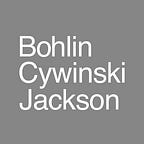Reimagining the Rust Belt — Building Authentic, Sustainable Ecosystems for Innovation
The industrial buildings that have long contributed to Pittsburgh’s character present a unique opportunity for considering the future. For architects, these buildings offer a tactile and fertile framework for reimagination and re-use — an opportunity to weave sustainability and community into a project’s DNA, and, in turn, foster equitable outcomes and hyper-local innovation.
On Tuesday, September 29th, Bohlin Cywinski Jackson held the latest virtual event in our Year of Gathering series, focused on the power of adaptive re-use in post-industrial cities like Pittsburgh to strengthen communities and create authentic and sustainable ecosystems for innovation. Kent Suhrbier, AIA, a principal in Bohlin Cywinski Jackson’s Pittsburgh studio, was joined by Don Carter, FAIA, a senior research fellow at the Remaking Cities Institute at Carnegie Mellon University; Petra Mitchell, president and CEO of Catalyst Connection, a not-for-profit that provides consulting and training services to manufacturers; and Alicia Volcy with Studio Volcy, a design and development consultancy.
“Territorial Assets” and Quality of Place
Kent framed the discussion by highlighting a passage from Don’s book Remaking Post-Industrial Cities: Lessons from North America and Europe, which draws on findings that creative and entrepreneurial people, including many young professionals, gravitate to cities that have “talent, technology, tolerance, and territorial assets.” Pittsburgh is often cited as a successful example of a manufacturing hub evolving over time — a place where businesses large and small, universities, and community organizations now thrive. Bohlin Cywinski Jackson has experienced this evolution first-hand, breathing new life into Pittsburgh’s “territorial assets” like the Senator John Heinz History Center, and creating places for creativity and technology to flourish, including the recently completed ANSYS Hall at Carnegie Mellon University.
Sustainable Development
Don described some of the ways adaptive re-use complements sustainable development, including leveraging existing infrastructure and the embedded energy of a building, as well as the creation of new uses in existing neighborhoods near established public transit. From a holistic perspective, it is important to celebrate our culture and built environment and pass these things on to the next generation. Once a building is lost, it is lost forever.
Responding to a question on how DoD manufacturing, in particular the shale gas industry, can co-exist with sustainability, Petra shared that business leaders in the industry have readily adopted requirements put forth, including the integration of advanced, more efficient equipment. She also noted that one of the reasons Pittsburgh has such a strong manufacturing industry now is the ability of existing companies to add technologies over time while remaining in place. Many businesses have leveraged this stability to be increasingly productive, efficient, and globally competitive.
Incremental Change
Alicia raised the importance of thoughtful planning in creating the next best thing for a neighborhood while maintaining its unique characteristics. She noted the way rapid development can leave key stakeholders out of the process and lead to projects that don’t embrace the existing fabric of the community. Careful stewardship of the built environment can be especially important here — by taking something that exists and making it better, long-serving buildings become a resource for future use, rooted in place and context.
“If we’re doing [adaptive re-use development] right, it means recruiting locals, investing in local organizations, and not creating a protected fortress.”
— Don Carter, FAIA, Remaking Cities Institute at Carnegie Mellon University
Virtual Place and Adaptation
While the pandemic continues to have a profound effect on our lives, the panelists were optimistic about how our current moment can offer positive lessons for the future. Petra reflected on the quick actions of many manufacturing companies to keep workers safe and maintain production at the start of the pandemic. The well-managed response from the manufacturing sector has continued, and its resiliency is evident in increased output and hiring.
Alicia brought up the difficulty in fostering walkable neighborhoods in a socially distanced time, and the associated challenges for small businesses that rely on street traffic. But she also noted that these abrupt changes have led companies to implement multi-faceted approaches to reaching and connecting with customers.
“We’re being forced to come up with new ways of doing business at the street level as well as online … It’s important for the businesses I work with to have that online presence so they can sustain themselves, so when it’s time to go back to a more walkable place, they can be there.”
— Alicia Volcy, Owner of Studio Volcy
Authentic Sense of Place
Catalyst Connection’s headquarters, inside a converted steel mill in Pittsburgh’s Hazelwood Green development, is a perfect example of the balance between old and new in the city. It is a poignant reminder of its steelmaking heritage and a new home for companies focused on the future of manufacturing, research and development. Pittsburgh has inherited from a culture of manufacturing that started in the 1850s — a work ethic, natural and built resources, a transportation system — and has the opportunity to continue to overlay with care on this rich history.
Watch the Recording
Further Reading
Year of Gathering
Buy your copy of Gathering
Revitalizing Pittsburgh: Adaptive Re-Use in a Changing Neighborhood
Extending the Life of Outdoor Campus Spaces
